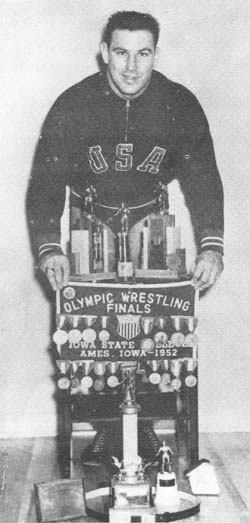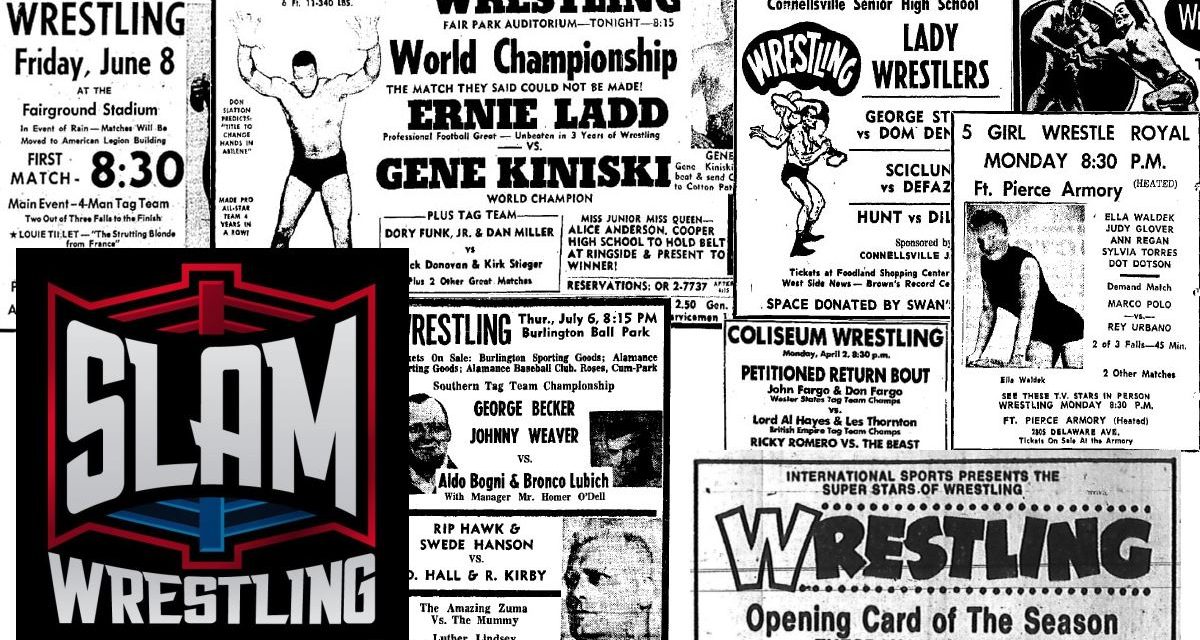Sometimes a death flies under the radar, and no one takes note. It just shouldn’t happen to someone who went to the Olympics in wrestling in 1952, and worked as a pro for a decade. It shouldn’t have happened to Jim LaRock.
The name probably won’t ring too many bells with today’s wrestling fan; even hardcore amateur wrestling supporters might have trouble dredging up the name from the past, in part because he came from Ithaca College in upstate New York.

Jim LaRock. Courtesy Ithaca College
But to those from the area, his name still means something; in fact, Ithaca College has a Jim LaRock Award for its wrestlers, given to the grappler that scored the most pinfalls during the season.
“Everybody knows him basically from around this area. He’s the first All-American we had here [in wrestling],” said the current coach at Ithaca, Marty Nichols. “Jim’s a legend, obviously.”
Dave Auble was a standout wrestler at Ithaca High School and nearby Cornell University; Competing at 123 pounds, he won NCAA championships in 1959 and 1960 and finished fourth at the Olympics in Tokyo in 1964. A college teammate of Bob Marella, aka Gorilla Monsoon, Auble knew LaRock.
“He used to come into our high school practices. When I was in high school, I used to go to the Ithaca College competitions, so he was one of the guys that really inspired the younger kids to get involved in wrestling. I’ve seen him in competition, and had him teach me technique,” said Auble, who serves as a volunteer assistant coach with Ithaca’s wrestling team.
“He’s a legend in this region. I was asking about him, and unfortunately, I just started enquiring about him recently, and learned that he had passed away. I was saddened; I wished I’d gotten together with him,” Auble said.
Nichols echoed Auble’s sentiment; he didn’t learn about LaRock’s death on August 3, 2006, at the Claxton-Hepburn Medical Center in nearby Ogdensburg, NY, at age 81, until after the fact; “We all wanted to be there [for the funeral], and we didn’t know about it.”
Born September 3, 1924, James C. LaRock would attend Gloversville High School, graduating in 1942, before entering the Second World War, serving the U.S. Army. There, he earned a European-African Middle Eastern Campaign medal, an Army Good Conduct medal, and a World War II Victory medal.
After the war, LaRock excelled at wrestling, and was the central YMCA champion, national YMCA champion, and national AAU champion for two years. His older brother Wilford was equally skilled on the mat, and was also an AAU champion. (LaRock had two other brothers, Frank and Leon, and two sisters, Pauline “Polly” Yeaton and Margaret Smith.)
At Ithaca, LaRock took second in the 1950 NCAA wrestling tournament at 165 pounds, the same year he was named an All-American, and finished his collegiate career with 31 wins and 26 pins.
In a 1956 interview with a Washington State newspaper during his pro career, LaRock addressed his upbringing. “At home (Ithaca) we have a college and a university (Cornell) and both have wrestling, and the high school and the YMCA have wrestling,” LaRock said. “There’s a lot of interest in it around there.”
LaRock’s expertise was in leg wrestling, said Auble. “Cornell and Ithaca College became known as a center for high-caliber leg technicians,” explained Auble. “They didn’t use legs out West, and the eastern wrestlers kind of specialized in mat wrestling, and leg technique.” One of the future stars LaRock inspired was Tim Woodin, who was from Ithaca, and would go on NCAA crowns and to become a wrestling superstar as Tim Woods and under a mask as Mr. Wrestling.
In July 1952, LaRock was beaten by Bill Smith in Annapolis, Maryland in a meet that determined the U.S. Olympic team. Smith would compete in Helsinki, and LaRock went as his alternate at the 160.5 pound limit. Smith would take gold in the Welterweight division in freestyle wrestling.
Columbus, Ohio promoter Al Haft is credited with getting Jim LaRock into pro wrestling, and LaRock’s debut was in early 1954.
Auble understood the dilemma that LaRock faced. “If you wanted to stay involved in sports as a wrestler, your only choice — if you were big enough — was to go into pro wrestling,” Auble said. “Now the USA Wrestling supports wrestlers to continue and train and compete on the international level, whereas we had to support ourselves back when I was training and wrestling. We were all struggling, with families, working full-time, and training to try to go to competitions. We kind of looked at it as an interesting and fun type thing. We’d joke about it. We knew it wasn’t real wrestling. They’d come back and show us some of the techniques.”
After five years at Ithaca, earning a bachelor of science degree in 1951, and a master of science degree in 1952, LaRock was apparently offered a job as a wrestling coach at another New York college, but opted to turn pro.
“It’s simply a matter of money,” LaRock said. “You can make more wrestling here than you can teaching there.”
On August 9, 1962, LaRock would marry Marie Elizabeth Cadle in Corinth, Miss. The couple had one son and four daughters. Marie predeceased her husband, dying May 18, 1990.
LaRock would go to work at Heuvelton Central School in Heuvelton, NY, where he was a science and physical education teacher, and coach of the football and wrestling teams. He retired in 1989.
Accounts of LaRock’s pro career indicate a willingness to hit towns big and small for a payday, and his past was a great promotional vehicle for him. “LaRock, one of the country’s best ‘leg wrestlers,’ proved his point by using a rolling leg split to pin his man in 12 minutes of the first fall, and the Indian death lock in nine minutes of the second fall,” has one account of a match in Lima, Ohio, against Martino Angelo.
“Yuma professional wrestling fans will have the chance tonight to see Jim LaRock, billed as one of the most outstanding Olympic wrestlers in the business,” reads a 1956 preview. “LaRock, who was never defeated as an amateur, has won more medals than any other wrestler. His record since turning pro is almost as outstanding. Tonight LaRock will test his skill against Black Hawk, the Seneca Indian Brave in a one fall contest.”
LaRock’s wore the grappling uniform of an Olympic team member to the ring — black trunks with red “long-handles” covering his legs, and a red, white and blue warmup jacket with USA emblazoned on the front. Needless to say, wearing such an outfit meant that he worked as a babyface.
In 1958, LaRock was recognized as the NWA U.S. Junior Heavyweight champion for a time, based out of Oklahoma. His other major claim to fame as a professional was wrestling on the very first match ever seen on Wrestling From the Chase TV program in St. Louis, going to a draw against Morris Shapiro, aka Mighty Atlas.












